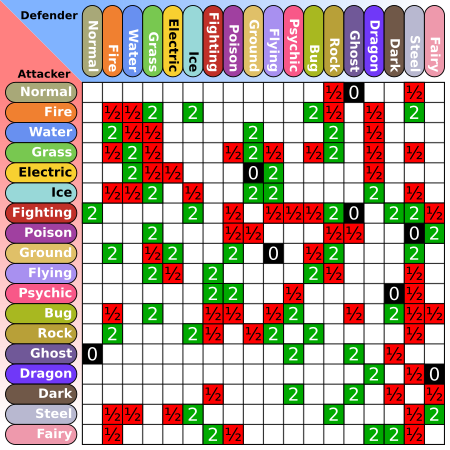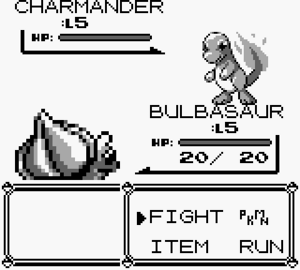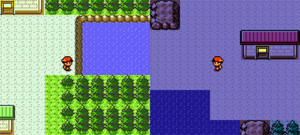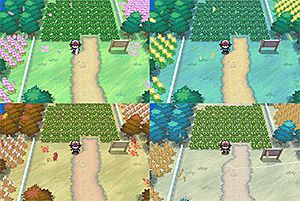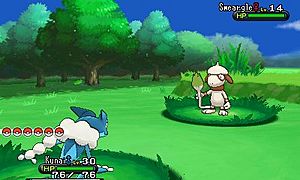Pokémon (video game series) facts for kids
Quick facts for kids Pokémon |
|
|---|---|
 |
|
| Genre | Role-playing |
| Developers | Game Freak ILCA |
| Publishers | |
| Creator | Satoshi Tajiri |
| Artist | Ken Sugimori |
| Composer | Junichi Masuda |
| Platforms | |
| First release | Pocket Monsters Red and Green (Japan) February 27, 1996 |
| Latest release | Pokémon Scarlet and Violet November 18, 2022 |
| Spin-offs | See List of Pokémon spin-offs |
Pokémon is a super popular series of video games. It was created by Satoshi Tajiri and developed by Game Freak. The games are published by Nintendo and The Pokémon Company.
The very first Pokémon games, Pocket Monsters Red and Green, came out in Japan in 1996 for the Game Boy. Later, these games were released around the world as Pokémon Red Version and Blue Version. These main games are role-playing games (RPGs). They have continued to be released on every new Nintendo handheld console. The newest main games, Pokémon Scarlet and Violet, were released on November 18, 2022, for the Nintendo Switch.
Besides Game Freak, other companies help make Pokémon games. Creatures helps by creating the 3D models for the Pokémon in the games. They also make some spin-off games. In 1998, Nintendo, Creatures, and Game Freak started The Pokémon Company together. This company handles everything about the Pokémon brand, like making sure the games, shows, and toys are all great.
The main Pokémon games are released in "generations." Each new generation brings new Pokémon, new stories, and new characters. Sometimes, older games are remade for newer consoles. While the main games are RPGs, there are many other types of Pokémon games. These "spin-off" games include action games, puzzle games, fighting games, and even digital pet games.
Pokémon is one of the biggest media franchises ever! It has successful TV shows, movies, and lots of merchandise. The spin-off game Pokémon Go has been downloaded over a billion times worldwide. By 2017, more than 300 million Pokémon games had been sold. As of 2023, over 480 million Pokémon games have been sold. This makes Pokémon the third best-selling video game franchise, right after Nintendo's own Mario and Tetris.
Contents
- How to Play Pokémon Games
- Pokémon Generations: A Journey Through Time
- First Generation: The Beginning (1996–1998)
- Second Generation: New Features and Colors (1999–2001)
- Third Generation: Double Battles and Abilities (2002–2005)
- Fourth Generation: Online Play and 3D Graphics (2006–2009)
- Fifth Generation: Seasons and Sequels (2010–2012)
- Sixth Generation: Full 3D and Mega Evolution (2013–2015)
- Seventh Generation: Alolan Forms and Z-Moves (2016–2018)
- Eighth Generation: Dynamax and Expansions (2019–2021)
- Ninth Generation: Open World Adventures (2022–Present)
- Other Pokémon Games
- See also
How to Play Pokémon Games
Most Pokémon games share some fun features. At the start of your adventure, you get to choose one of three "starter Pokémon." These are usually Grass-type, Fire-type, or Water-type Pokémon. For example, in Pokémon Red and Blue, you could pick Bulbasaur (Grass), Charmander (Fire), or Squirtle (Water).
There's one special game, Pokémon Yellow, where you start with Pikachu. Pikachu is an Electric-type mouse Pokémon and the mascot of the whole Pokémon world! In Pokémon Yellow, you can also get the other three starter Pokémon later in the game.
In most games, your rival (another trainer) will pick a starter Pokémon that has an advantage over yours. For example, if you pick the Fire-type Charmander, your rival will pick the Water-type Squirtle. Water is strong against Fire! However, this doesn't affect your very first battle.
Some games have different rules for rivals. In Pokémon Black and White, you have two rivals. One picks a Pokémon strong against yours, and the other picks one weak against yours. In Pokémon Diamond, Pearl, and Platinum, another trainer picks a Pokémon weak against yours, but they battle alongside you instead of against you.
Pokémon X and Y even have four rivals! Two of them get starter Pokémon like in Black and White, while the other two have different Pokémon entirely.
Pokémon Generations: A Journey Through Time
The Pokémon world grows with each new "generation" of games. A new generation starts when a main game is released with new Pokémon, characters, and ways to play. The TV shows, manga, and trading card games also get updated with these new Pokémon. The Pokémon series is currently in its ninth generation.
First Generation: The Beginning (1996–1998)
The very first Pokémon games were Pocket Monsters Red and Green, released in Japan for the Game Boy. They were role-playing games with strategy elements. Because they were so popular, an improved Blue version came out. This Blue version was then changed for international release as Pokémon Red and Blue. The original Green version was never released outside Japan.
Later, Pokémon Yellow was released. This game used the colors of the Game Boy Color and looked more like the popular Pokémon TV show.
This first generation introduced the original 151 Pokémon species, from Bulbasaur to Mew. It also taught players how to catch, train, battle, and trade Pokémon. These games took place in the Kanto region.
Many spin-off games came out during this time. These included Pokémon Pinball, a Pokémon Trading Card Game adaptation, and Pokémon Snap, where you took pictures of Pokémon. There was also Pokémon Puzzle League and Pokémon Stadium, which brought Pokémon battles to 3D on the Nintendo 64.
Second Generation: New Features and Colors (1999–2001)
The second generation began in 1999 with Pokémon Gold and Silver for the Game Boy Color. An improved version, Pokémon Crystal, was released later.
This generation added 100 new Pokémon, bringing the total to 251. It also brought exciting new features:
- A day-and-night system that changed the game based on the real time.
- Full use of the Game Boy Color's bright colors.
- Two new Pokémon types: Dark and Steel, to make battles more balanced.
- Pokémon breeding, allowing you to hatch new Pokémon from eggs.
- A new region called Johto. After exploring Johto, you could even travel back to the Kanto region from the first games!
Spin-off games included Pokémon Puzzle Challenge and Pokémon Stadium 2 for the Nintendo 64. The Pokémon Mini was also released, which was a tiny handheld console just for Pokémon mini-games.
Third Generation: Double Battles and Abilities (2002–2005)
The third generation started in 2002 with Pokémon Ruby and Sapphire for the Game Boy Advance. Later, remakes of the first games, Pokémon FireRed and LeafGreen, were released. An improved version of Ruby and Sapphire, called Pokémon Emerald, also came out.
This generation introduced 135 new Pokémon, making a total of 386 species. The games looked more detailed than before. New features included:
- "Natures" for Pokémon, which affected their stats.
- New 2-on-2 Pokémon battles, called "double battles."
- A special ability system for each Pokémon.
- The Pokémon Contest sub-game, where you showed off your Pokémon's style.
- A new region called Hoenn.
- The ability to choose your character's gender.
- Secret Bases, where you could decorate your own hidden room.
Some fans missed the day-and-night system from the previous generation. However, the franchise became very popular again during this time.
Spin-off games included Pokémon Pinball: Ruby & Sapphire, Pokémon Mystery Dungeon: Blue Rescue Team and Red Rescue Team, and Pokémon Ranger. Two new RPGs for the GameCube, Pokémon Colosseum and Pokémon XD: Gale of Darkness, were also released.
Fourth Generation: Online Play and 3D Graphics (2006–2009)
In 2006, the fourth generation began with Pokémon Diamond and Pearl for the Nintendo DS. Pokémon Platinum was released later as an improved version of Diamond and Pearl. Also, Pokémon Gold and Silver were remade for the Nintendo DS as Pokémon HeartGold and SoulSilver.
This generation added 107 new Pokémon, bringing the total to 493. It was the first main series game to use 3D graphics for some parts, like backgrounds, while still keeping 2D sprites for characters and Pokémon. Key new features included:
- A new system for Pokémon moves.
- Online multiplayer trading and battling using Nintendo Wi-Fi Connection.
- The return and improvement of the day-and-night system.
- Expanded Pokémon Contests, now called "Super Contests."
- A new region called Sinnoh, which had an underground area for multiplayer fun.
- HeartGold and SoulSilver added the Pokéathlon, a series of Pokémon sports events.
Spin-off games included Pokémon Battle Revolution for Wii and Pokémon Ranger: Shadows of Almia. Pokémon also appeared in the fighting game Super Smash Bros. Brawl.
Fifth Generation: Seasons and Sequels (2010–2012)
The fifth generation started in 2010 with Pokémon Black and White for the Nintendo DS. These games took place in the Unova region. New features included:
- The C-Gear, for Wi-Fi options and customizations.
- New battle methods like "Triple Battles" (three Pokémon at once) and "Rotation Battles."
- Pokémon Musicals, where trainers used their Pokémon to dance.
- Technical Machines (TMs) could be used multiple times.
Unlike previous generations, this one had direct sequels: Pokémon Black 2 and White 2. These games took place two years later in the Unova region with new main characters. They also introduced the "Pokémon World Tournament," where you could battle gym leaders and champions from older regions.
This generation added the most new Pokémon so far, with 156 new species. It also introduced seasons, which changed the game world. All the new Pokémon in this generation were completely new, not evolutions of older Pokémon.
Spin-off games included Pokémon Rumble Blast for Nintendo 3DS and PokéPark 2: Wonders Beyond for Wii. There were also educational games like Learn with Pokémon: Typing Adventure and reference apps like Pokédex 3D.
Sixth Generation: Full 3D and Mega Evolution (2013–2015)
The sixth generation began on October 12, 2013, with Pokémon X and Y for the Nintendo 3DS. These games were the first to be rendered in full 3D! You could also customize your trainer's look. The starter Pokémon were Chespin (Grass), Fennekin (Fire), and Froakie (Water).
In May 2014, Pokémon Omega Ruby and Alpha Sapphire were announced. These were remakes of the third generation games, Pokémon Ruby and Sapphire. They were released in November 2014.
This generation introduced 72 new Pokémon. It also brought:
- A new Fairy-type Pokémon.
- Mega Evolution, a temporary powerful form for some Pokémon.
- The Kalos region.
- New battle modes like Sky Battles and Horde Encounters.
- Compatibility with Pokémon Bank, a service to store your Pokémon online.
Spin-off games included Pokkén Tournament, a fighting game, and the hugely popular augmented reality game Pokémon Go for mobile devices.
Seventh Generation: Alolan Forms and Z-Moves (2016–2018)
In February 2016, Pokémon Sun and Moon were announced. They were released on the Nintendo 3DS in November 2016. These games were special because they could connect with older games like Pokémon X and Y. In June 2017, Pokémon Ultra Sun and Ultra Moon were announced. These games added new parts to the story of Sun and Moon.
In May 2018, Pokémon: Let's Go, Pikachu! and Pokémon: Let's Go, Eevee! were announced. These were remakes of Pokémon Yellow with gameplay ideas from Pokémon Go. They were released on the Nintendo Switch in November 2018.
This generation introduced 88 new Pokémon. It also brought:
- Alolan forms, which were different versions of older Pokémon adapted to the Alola region.
- Trials instead of traditional gyms.
- Z-moves, powerful special attacks.
- Poké Pelago and Festival Plaza, new areas for your Pokémon and for interacting with other players.
Eighth Generation: Dynamax and Expansions (2019–2021)
In February 2019, Pokémon Sword and Shield were confirmed for the Nintendo Switch. They were released worldwide on November 15, 2019. These games took place in the Galar region. New features included:
- Galarian forms, similar to Alolan forms.
- The Champion Cup, a big tournament.
- Dynamax and Gigantamax forms, making Pokémon huge and powerful.
- Max Raid battles, where multiple players could team up against a giant Pokémon.
- Pokémon Camp, where you could play with your Pokémon.
In January 2020, two expansion packs were announced: The Isle of Armor and The Crown Tundra. These added new areas and Pokémon to the games.
In February 2021, remakes of the fourth generation games, Brilliant Diamond and Shining Pearl, were announced. Also, Pokémon Legends: Arceus was announced, which was a prequel to Diamond and Pearl with a new style of gameplay. Brilliant Diamond and Shining Pearl came out in November 2021, and Pokémon Legends: Arceus in January 2022.
This generation introduced 96 new Pokémon across Sword and Shield, their expansions, and Pokémon Legends: Arceus.
Ninth Generation: Open World Adventures (2022–Present)
The ninth generation began on February 27, 2022, with the announcement of Pokémon Scarlet and Violet for the Nintendo Switch. These games were released on November 18, 2022. They were the first main series games to feature a truly open world.
On February 27, 2023, a two-part expansion pack was announced: The Hidden Treasure of Area Zero. Part One, The Teal Mask, was released in September 2023. Part Two, The Indigo Disk, was released in December 2023. An extra story, Mochi Mayhem, came out in January 2024.
This generation has introduced 120 new Pokémon so far, bringing the total number of Pokémon to over 1000!
Other Pokémon Games
Besides the main series, many other Pokémon games have been released. These include games for computers and even for other consoles like the Sega Pico.
Pokémon in Super Smash Bros.
Many Pokémon characters have appeared in the Super Smash Bros. fighting game series. These include Pikachu, Jigglypuff, Pichu, Mewtwo, Lucario, Greninja, and Incineroar.
Pikachu and Jigglypuff have been in every Super Smash Bros. game since the first one on the Nintendo 64. Other Pokémon like Squirtle, Ivysaur, and Charizard can be played as part of the Pokémon Trainer character.
The Super Smash Bros. games also feature Poké Balls as items. When you use a Poké Ball, a random Pokémon appears and can help you in the battle! Some rare Pokémon like Mew and Palkia can appear from Master Balls. Some Pokémon even appear as dangers on the stages, like Rayquaza.
See also
 In Spanish: Pokémon (serie de videojuegos) para niños
In Spanish: Pokémon (serie de videojuegos) para niños


